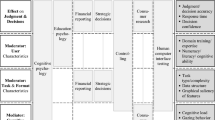Abstract
This paper addresses the problem of describing the decision-making process of a committee of engineers based upon their verbalized linguistic appraisals of alternatives. First, we show a way to model an individual’s evaluation of an alternative through natural language based on the Systemic-Functional Linguistics system of APPRAISAL. The linguistic model accounts for both the degree of intensity and the uncertainty of expressed evaluations. Second, this multi-dimensional linguistic model is converted into a scalar to represent the degree of intensity and a probability distribution function for the stated evaluation. Finally, we present a Markovian model to calculate the time-varying change in preferential probability, the probability that an alternative is the most preferred alternative. We further demonstrate how preferential probability toward attributes of alternatives correspond to preferential probability toward alternatives. We illustrate the method on two case studies to highlight the time-variant dynamics of preferences toward alternatives and attributes. This research contributes to process tracing in descriptive decision science to understand how engineers actually take decisions.












Similar content being viewed by others
Notes
An alternative approach would be to normalize the transition matrix at this step such that the axioms of probability are satisfied. We have experimented with this approach and found that it results in the loss of numerical distinction between the preferential probabilities over time. It is thus numerically advantageous not to scale the transition matrix at each iteration, but rather to rescale the preferential probabilities in the final step, Eq. 8.
References
Dong A (2009) The language of design: theory and computation. Springer, London
Dong A, Kleinsmann M, Valkenburg R (2009) Affect-in-cognition through the language of appraisals. Des Stud 30(2):138–153
Dym CL, Wood WH, Scott MJ (2002) Rank ordering engineering designs: pairwise comparison charts and Borda counts. Res Eng Design 13(4):236–242
Frey D, Herder P, Wijnia Y, Subrahmanian E, Katsikopoulos K, Clausing D (2009) The pugh controlled convergence method: model-based evaluation and implications for design theory. Res Eng Design 20(1):41–58
Frishammar J, Floren H, Wincent J (2011) Beyond managing uncertainty: Insights from studying equivocality in the fuzzy front end of product and process innovation projects. IEEE Trans Eng Manag 58(3):551–563
Garbuio M, Lovallo D (2011) The under-appreciated role of quality conversations in strategic decision-making. In: 71st annual meeting of the academy of management AoM 2011. Academy of Management
Gigone D, Hastie R (1997) The impact of information on small group choice. J Pers Soc Psychol 72(1):132–140
Hayes AF, Krippendorff K (2007) Answering the call for a standard reliability measure for coding data. Commun Methods Meas 1(1):77–89
Ji H, Yang M, Honda T (2012) An approach to the extraction of preference-related information from design team language. Res Eng Design 23(2):85–103
Kahneman D, Lovallo D, Sibony O (2011) Before you make that big decision. Harv Bus Rev 89(6):50–60
Kim J, Wilemon D (2002) Focusing the fuzzy frontend in new product development. R&D Manag 32(4):269–279
Le Dantec CA, Do EYL (2009) The mechanisms of value transfer in design meetings. Design Stud 30(2):119–137
Martin JR, White PRR (2005) The language of evaluation: appraisal in English. Palgrave Macmillan, New York
Paolacci G, Chandler J, Ipeirotis PG (2010) Running experiments on amazon mechanical turk. Judgm Decis Mak 5(5):411–419
Pugh S (1991) Total design: integrated methods for successful product engineering. Addison-Wesley, Reading
Reich Y (2010) My method is better! Res Eng Design 21(3):137–142
Scott MJ, Antonsson EK (1998) Aggregation functions for engineering design trade-offs. Fuzzy Sets Syst 99(3):253–264
Sorokin A, Forsyth D (2008) Utility data annotation with amazon mechanical turk. In: IEEE computer society conference on computer vision and pattern recognition workshops, 2008. CVPRW’08, pp 1–8. doi:10.1109/CVPRW.2008.4562953
Subasic P, Huettner A (2001) Affect analysis of text using fuzzy semantic typing. IEEE Trans Fuzzy Syst 9(4):483–496
Thurston DL (1991) A formal method for subjective design evaluation with multiple attributes. Res Eng Design 3:105–122
Thurston DL (2001) Real and misconceived limitations to decision based design with utility analysis. J Mech Design 123(2):176–182
Ulrich KT, Eppinger SD (2004) Product design and development, 3rd edn. McGraw-Hill/Irwin, New York
Wasiak J, Hicks BJ, Newnes L, Dong A (2010) Understanding engineering email: the development of a taxonomy for identifying and classifying engineering work. Res Eng Design 21(1):43–64
Wasiak J, Hicks BJ, Newnes L, Loftus C, Dong A, Burrow L (2011) Managing by e-mail: what e-mail can do for engineering project management. IEEE Trans Eng Manag 58(3):445–456
Weick KE (1995) Sensemaking in organizations. Sage Publications, Thousand Oaks
Whitelaw C, Garg N, Argamon S (2005) Using appraisal groups for sentiment analysis. In: Proceedings of the 14th ACM international conference on information and knowledge management, CIKM’05, pp. 625–631. ACM, New York, NY, USA. doi:10.1145/1099554.1099714
Acknowledgments
The authors wish to thank the participation of the engineering students in the experiments. The work described in this paper was supported in part by the National Science Foundation under Award CMMI-0900255. This research was also supported in part under Australian Research Council’s Discovery Projects funding scheme (Project Number DP1095601). The opinions, findings, conclusions, and recommendations expressed are those of the authors and do not necessarily reflect the views of the sponsors.
Author information
Authors and Affiliations
Corresponding author
Rights and permissions
About this article
Cite this article
Dong, A., Sarkar, S., Yang, M.C. et al. A linguistic approach to assess the dynamics of design team preference in concept selection. Res Eng Design 25, 75–92 (2014). https://doi.org/10.1007/s00163-013-0165-1
Received:
Revised:
Accepted:
Published:
Issue Date:
DOI: https://doi.org/10.1007/s00163-013-0165-1




